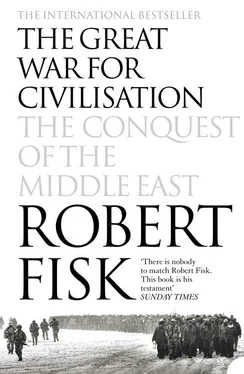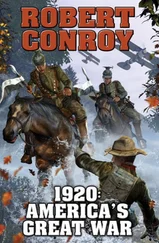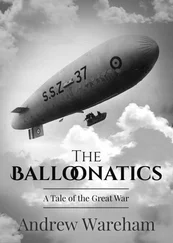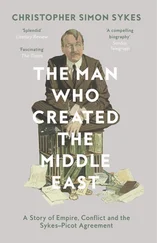On the bridge, an Indian radio operator could be heard pleading over VHF with an Iranian patrol ship. ‘We are only carrying dates,’ he said. ‘Only dates.’ The Iranian was 30 kilometres away. An Iranian P-3 reconnaissance aircraft answered. ‘Be aware,’ boomed the tannoy throughout Broadsword , ‘that yesterday the Iraqis launched an Exocet attack on a Maltese tanker carrying oil from Iran. We can therefore expect the Iranians to retaliate …’ A dog-day mist now swirled around the ship, leaving salt cakes across the flight deck. The two freighters were steaming beside us, an overheated version of every Second World War Atlantic convoy, because Broadsword , however unheroic in her humidity, was – like the American ships – a naval escort.
Back in 1984, when Iraq began this maritime conflict, the Gulf looked a lot simpler. The Arabs, protesting mightily at every attack by the Iranians and silent when the Iraqis struck at Iranian shipping, were almost as fearful of American involvement as they were of the Iranians. Saudi Arabia maintained a quiet relationship with Iran – just in case Iraq collapsed – while at the same time underwriting Saddam’s war. Ostensibly, the Arabs remained neutral -‘at war but skulking’, as Churchill unfairly remarked about the Irish in the Second World War – and offered refuge to any ship’s master who found himself under fire. Bahrain and Dubai would receive the crippled hulks of both sides’ aggression, profiting from the millions of dollars in repairs that their shipyards would make in reconstituting the ships. By 1987, eighteen had been hit twice, six had been attacked three times and two – Superior and Dena – had the distinction of being rocketed and repaired four times in four years. As early as May 1984 there was a floating junkyard of mortally wounded vessels off Bahrain.
They called it the ships’ graveyard and the term was cruelly appropriate. The great tankers that Iran and Iraq had destroyed were towed here in terminal condition, bleeding fuel oil into the warm, muddy brown waves in the very centre of the Gulf, a series of jagged holes in their scalded superstructure to show how they met their end. The Bahraini government even ran a patrol boat out to this maritime cemetery for journalists to understand what this war now represented. An Iranian Phantom hit the 29,000-ton Chemical Venture so accurately on 24 May that its missile plunged into the very centre of the bridge: there was a 12-metre sign there saying ‘No Smoking’ in the middle of the superstructure; the rocket took out the letters ‘S’ and ‘M’. The tanker crews along the Gulf were growing restive over the dangers; by the end of May, up to twenty-five ships were riding at anchor off the Emirates alone, waiting for instructions from their owners, and you only had to take a look at the ruin of the Al-Hoot to understand why. The 117,000-ton supertanker was listing with a hole the size of a London bus along her waterline where an Iraqi missile had exploded three weeks earlier. The superstructure had been twisted back and outwards over the stern and the crew’s quarters had simply melted down as if they were made of plastic rather than iron. The gash on the starboard side was so deep I could see daylight through it.
Just to the north lay the 178,000-ton Safina al-Arab , moving restlessly in the swell as a Swedish-registered tanker tried to take off the last of her crude oil. The stuff was everywhere, down the sides of the ship, across the water, turning even the foam on the waves dark. I could smell it from a mile away. The salvage crews – mostly Dutchmen – knew the risks but strolled the decks as if they were in harbour rather than sitting on bombs 115 kilometres out in the Gulf.
It was an isolated place. *On the map of the Middle East, the Gulf seemed just a crack in the land mass between the deserts of Arabia and southern Iran, but the seas could be rough and the horizon featureless save for the lonely and vulnerable tankers butting through the sirocco winds up to Ras Tanura and Kuwait. They had no convoys to sail in then, no protection from the air, and they crept in those days as close as they could to the southern shoreline. They passed us as we photographed the graveyard of their more unfortunate brethren, ill painted for the most part, plunging through the heat haze, targets of opportunity for either side in the upper reaches of the Gulf, depending on their masters and their ports of call.
The sea should have been polluted but it was alive with flying fish that landed on their tails, long yellow sea snakes that came up out of the green depths to look at us, and porpoises and even turtles. Big-beaked black cormorants effortlessly outflew our fast Bahraini patrol boat. The oil slicks came in thick, viscous patches and in long thin streaks that shredded their way up the pale blue water towards the wrecks. The only sign of President Reagan’s concern in those days was the discreet grey majesty of the USS Luce , a Seventh Fleet missile cruiser that lay all day off the Mina Salman channel outside Bahrain harbour, a picket boat filled with armed sailors slowly circling it to ward off unconventional attackers – an idea before its time, since the USS Cole would not be struck by suicide bombers in Aden for another decade. Besides, the radio traffic from the Luce , clearly audible on our own ship-to-shore radio, seemed mostly bound up with the complexities of bringing new video films aboard for the crew. A few hours later, a smaller US patrol craft moved into port and the Luce gently steamed off into the sweltering dusk, its in-house entertainment presumably updated.
But other American warships were – even then – playing the role of convoy escorts. This unofficial and unacknowledged protection was given no publicity in Washington, nor among the Arab states, coinciding with their own desire to keep the US navy over the horizon. Sometimes the escort was provided by the USS John Rodgers , a sleek, twin-funnelled missile cruiser that last defended American interests by bombarding the Chouf mountains of central Lebanon a year earlier. At other times, the USS Boone , a squat and rather cumbersome flat-topped missile carrier, came up by night from the Emirates and rested off Bahrain. Anyone who approached the warships by day – which we did, of course – would be confronted by a steel-helmeted US sailor manning a fixed heavy machine gun.
US air force cargo jets were already flying regularly into the airports of the Gulf states, carrying equipment so bulky that they were forced to deploy their giant C-48 droop-wing transports. These flights were being made to the countries that Reagan always called ‘our Arab friends’, a definition that no longer included Lebanon – from which US forces had been famously ‘redeployed to sea’ three months earlier, following the bombing of the Beirut marine barracks and the killing of 241 US servicemen – but which very definitely embraced the conservative oil states of the Gulf peninsula. If the Americans were to become strategically involved – as they would do three years later – then the Arab states would have to be portrayed, as I wrote in The Times in May 1984, ‘as the innocent party in the dispute: the Iranians, inevitably, will be the enemy’. And so it came to pass. Was it not Iranian aircraft, the Iranian regime and ultimately Iranian ideology that threatened the security of the area? Again, we would be expected to forget that Iraq began the war and that Iraq was the first to order its air force to attack oil tankers in the Gulf.
In the autumn of 1980, when it seemed certain to them that Khomeini’s regime would collapse in anarchy under the onslaught of the Iraqi army around Abadan, the Arab Gulf states – those very states which by 1984 were seeking UN censure of Iran for its air attacks on the shipping lanes – poured billions into Iraq’s war funds. But now that Iran’s Islamic Revolution had proved more tenacious than they thought, the Arabs were stapling their hopes to a worthless peace mission to Tehran and Riyadh by Syria, the one Arab country which very shrewdly decided at the beginning of the war that its Baathist enemies in Baghdad – rather than Khomeini’s mullahs – might prove to be the losers. The failure of the Arab Gulf states to draw the same conclusion had now led to a disjointed policy that was as impossible to follow as it would be to justify historically.
Читать дальше












